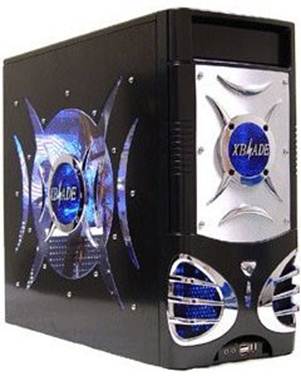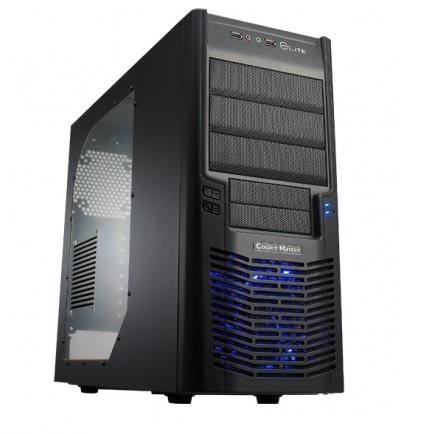Putting together a computer on budget means
making some tough decisions. Here, we'll help you do just that
Building a system is a potentially
stressful process, so why not leave it to the experts? We've looked at the example
pre-builds on Computer Planet's website (computerplanet.co.uk) and analyzed its
choices to help show you what you're looking for in a system, and how you might
want to modify them. Remember, this advice doesn't just pertain to these
specific systems - it's just that when analyzing systems, it's far easier to
show than tell!
To help get an even spread of advice, we've
looked at several types of pre-build, from gaming rigs to workstations to
silent systems, and we've divided the gaming systems up by budget so that you
can find relevant advice regardless of how much you want to spend. So sit back,
pour a mug of tea and enjoy some stress-free system analysis and advice that
you can take away and apply to your own choice of computer.
Budget Gaming PC: GX250 ($446)
If you're going for a budget system, you
might as well do it properly. Aimed squarely at the lowest end of the market,
the GX250 is the cheapest gaming system Computer Planet offers. It's hard
enough to assemble an entire desktop PC for under $481, let alone one capable
of gaming - after all, you can buy graphics cards that cost almost as much, but
it undeniably does the job.
There's no point pretending it matches up
to modern gaming PC standards, because it doesn't, but where it does excel is
in being good value for its price. The processor, for example, is an Athlon II
X2 250. Despite being three years old, it's one of the best value CPUs you can
get in terms of price to power ratio, so if you're financially unable to pay
any more than $80 for a CPU, it's easily the best choice. Better value than the
similarly aged Intel Core i7 960, for example.
If you're using the system solely for
gaming, then 2GB isn't going to cause any problems.

Budget
Gaming PC: GX250
The graphics card is a GeForce GT 610
which, despite a promising model number, doesn't actually contain the 6-series
28nm Kepler architecture. It's actually a rebadged GeForce GT 520, which uses
last-generation 40nm Fermi architecture. In terms of raw power, it's roughly
comparable to the Intel HD Graphics 4000 chips found on high-end Ivy Bridge
platforms, but at the same time, it's still a good deal better than the Intel
HD Graphics 2000 and 3000 found on Sandy Bridge chips.
The rest of the specs are fair enough,
although a 700-watt power supply is far more than this system needs, especially
when you consider that the graphics card - typically the biggest individual
power drain on any system - requires a paltry 29W. The reason it packs such a
punch is the case. The cheap yet imposing X-Blade comes with its own PSU, so
select a cheaper case and you'll also have the option for a less meaty power
supply - although you do swap a stylish exterior for a more generic one as a
result.
If you were to upgrade any part of the
system prior to purchase, it should probably be the RAM. 2GB is the bare
minimum for a Windows 7 system, and 4GB is much more preferable. Admittedly, if
you're using the system solely for gaming then 2GB isn't going to cause any
problems, but if you plan to use the system for anything else it'll start to
cause trouble when multitasking. The 80GB hard drive is also seriously lacking
in capacity, but at least the 10,000rpm platter speed will mean improved gaming
performance.
Overall, it's as good a system as you can
expect for the price. The budget has clearly been allocated to the parts of the
system that'll make gaming run as smoothly as possible, even if that's at the
expense of things like hard drive space and RAM capacity. Only the power supply
is out of place, and even that can be rectified with a little tweaking.
|
Specifications
CPU: AMD
Athlon 250 (2 x 2.5GHz)
RAM: 2GB
DDR3 1333MHz
HDD: 80GB
SATA-II 10000rpm
Case:
X-Blade Black
Graphics Card:
NVidia GeForce GT 610 - 1GB
Optical Drive:
22x dual-layer DVD/CD rewriter
Power Supply:
700W PSU
CPU Cooling:
AMD heat sink and fan
Motherboard: Asus
Sound: 7.1
HD sound
USB Ports:
6 x USB 2.0 and 2 x USB 3.0
|
High End Gaming PC: GX2000 ($1286)

High
End Gaming PC: GX2000
Even at more than double the price of the
GX250, Computer Planet's higher-end gaming PC can compete with current systems
without being priced ridiculously. The GX2000 is the first pre-build system to
feature an Intel chip, a choice we believe is essential to any modern gaming
system. That is why we've chosen it as our high-end choice.
The CPU is an i5 3550, which is one of the
Intel's latest Ivy Bridge chips, with 22nm process technology and 6MB of
level-3 cache. The on-board graphics is Intel HD Graphics 2500, but don't
worry, you won't be using it. As good as this chip is, though, we recommend you
spend an extra tenner on either the Core i5 2500K or the Core i5 3570k. They
will allow you to overclock the chip and squeeze even better performance from
your money - and since the Arctic Freezer 7 CPU cooler is around 30% better
than Intel's own, the system should be capable of handling any reasonable
temperature increase.
8GB of RAM is more than adequate for any
gaming system; the Corsair branding means you'll get good performance and will
likely allow you to overclock it if you're comfortable doing so. A 1TB SATA-III
hard drive is well up to current standards. An SSD would substantially improve
performance, but you'd be looking at an extra $160 - $320. A 600-watt PSU is
more than reasonable for this kind of system, and the case - a Cooler Master
Elite 430 - is stylish, convenient and spacious.
Push it into overclock territory and watch
it fly - particularly when you have Corsair's H60 liquid cooling.
The graphics card, a GeForce GTX 570, might
be last-generation technology, but don't think that makes it a step down. It
offers performance superior to most of the 6-series range, and roughly equal to
the GeForce GTX 660, which, since its release in September, has become the
Gamer's Best Friend.
You also get an operating system included
in the price, but if you have one already you can shave $112 off the price,
making this an even better deal. Aside from that, the only modification you
need to make is the CPU - bump it up to one with an unlocked multiplier
(they're the ones with the 'K' suffix on their model name) and make sure you
take advantage of the extra speed overclocking offers!
|
Specifications
CPU: Intel
i5 3550 (4 x 3.3GHz)
RAM:
Corsair 8GB DDR3 1333MHz
HDD: 1 TB
SATA-III 7200rpm
Case:
Cooler Master Elite 430
Graphics Card: NVidia GeForce GTX 570 1.28GB
Optical Drive: 22x dual-layer DVD/CD rewriter
Power Supply: Cooler Master 600W PSU
CPU Cooling: Arctic Freezer 7
Motherboard: Asus
Sound: 7.1
HD sound
USB Ports:
6 x USB 2.0 and 2 x USB 3.0
Operating System: Windows 7 Home Premium 64-Bit
|